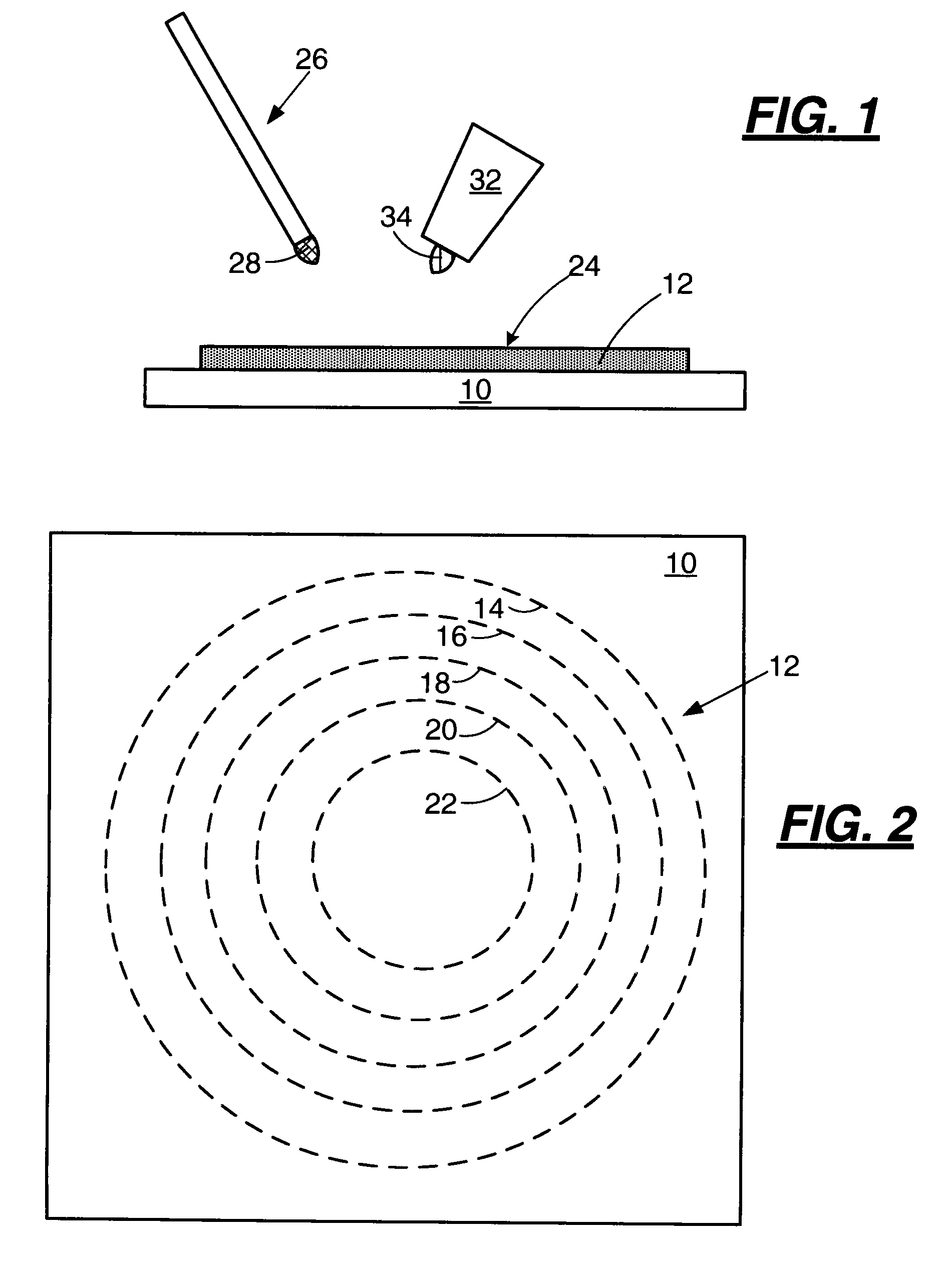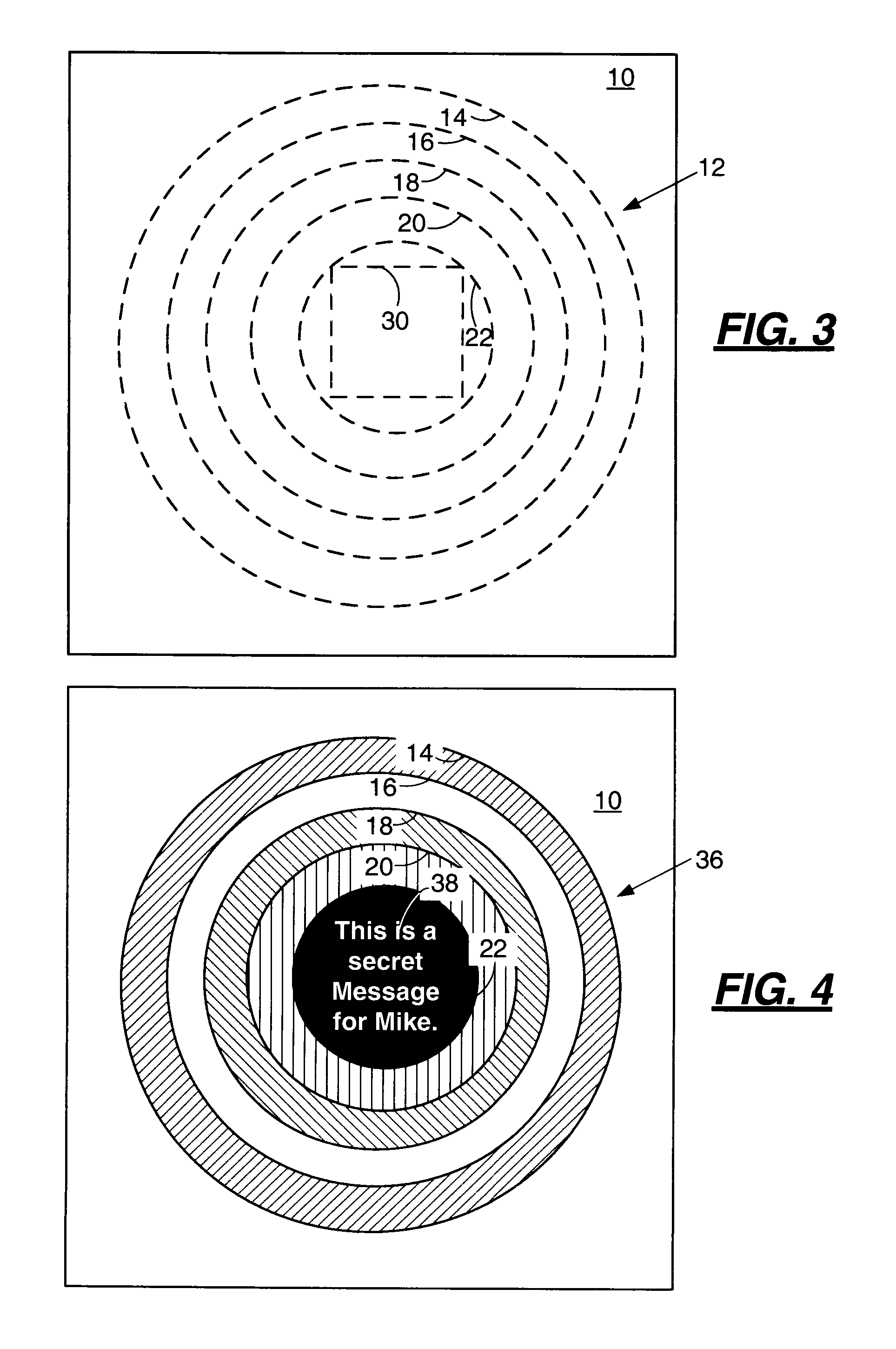Latent image developing systems and devices
a technology of developing systems and devices, applied in the direction of inks, printing, pattern printing, etc., can solve the problems of weak development and/or lack of vibrant well defined colors, blurry images, toxic or hazardous effects of developer or solvent, etc., and achieve excellent resolution, vibrant colors, and high color intensity.
- Summary
- Abstract
- Description
- Claims
- Application Information
AI Technical Summary
Benefits of technology
Problems solved by technology
Method used
Image
Examples
first embodiment
[0025]In the disclosure illustrated in FIGS. 1-4, a substrate is provided with a latent image 12 printed thereon. The substrate 10 may be made from a wide variety of materials including, but not limited to, paper, wood, polyester, polystyrene, polypropylene, ceramic, metal, natural and synthetic cloth or fabric, and the like. A suitable plastic substrate 10 is polyester. Likewise, suitable paper substrates 10 include offset, matte or coated papers. A particularly useful paper substrate is offset paper available from Boise Cascade and MeadWestvaco paper companies and has a weight of about 50 to about 70 pounds per ream.
[0026]The latent image 12 may be printed on the substrate 10 by a wide variety of printing techniques including, but not limited to, flexographic, lithographic, sheet fed, web offset, rotogravure, gravure, screen printing, ink jet printing, and variable image printing techniques. Printing techniques which may be used to print the latent image 12 on the substrate 12 inc...
second embodiment
[0046]In the disclosure, prior to developing the latent image 12, a secret message may be written on the latent image 12 as indicated by the broken-line rectangle 30 in FIG. 3. The secret message may be written by applying a blocking composition from a blocking marker 32 having a felt dispensing tip 34 to selected portions of the latent image 12. The blocking marker 32 may be used to prevent development of selected portions of the latent image 12.
[0047]A suitable blocking composition for blocking development of the latent image 12 in the rectangle 30 may an amine compound dissolved in water. A particularly suitable amine compound is triethanolamine. Accordingly, the blocking formulation may include from about 15 to about 35 weight percent triethanolamine and from about 65 to about 85 weight percent water. Above this range, the blocking composition may be less effective. While not desiring to be bound by theory, it is believed that the blocking composition may absorb less into the su...
third embodiment
[0052]the disclosure is illustrated in FIGS. 5-8. FIG. 5 illustrates construction of a second substrate 40 containing an image developing layer such as color developer layer 42 on a surface 44 thereof. Like the first substrate 10, the second substrate 40 may be selected from glass, ceramic, porous materials such as natural or synthetic paper and substantially transparent polymeric films such as films made from polyethylene, polypropylene, polyvinyl chloride, polystyrene, polyester, polybutylene and the like, provided at least one of the first or second substrates is a substantially transparent polymeric film.
[0053]Substantially transparent films useful as the first substrate 10 or second substrate 40 preferably have a thickness that may range from about 10 to about 100 microns. Particularly preferred films are substantially optically clear, about 50 micron thick, and are print receptive films. Such films include, but are not limited to, polyethylene terephthalate (PET) films availab...
PUM
| Property | Measurement | Unit |
|---|---|---|
| weight percent | aaaaa | aaaaa |
| weight percent | aaaaa | aaaaa |
| thickness | aaaaa | aaaaa |
Abstract
Description
Claims
Application Information
 Login to View More
Login to View More - R&D
- Intellectual Property
- Life Sciences
- Materials
- Tech Scout
- Unparalleled Data Quality
- Higher Quality Content
- 60% Fewer Hallucinations
Browse by: Latest US Patents, China's latest patents, Technical Efficacy Thesaurus, Application Domain, Technology Topic, Popular Technical Reports.
© 2025 PatSnap. All rights reserved.Legal|Privacy policy|Modern Slavery Act Transparency Statement|Sitemap|About US| Contact US: help@patsnap.com



